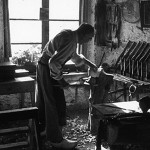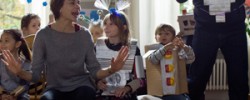
TIFF’s Bitter/Sweet The Joyous Cinema of Jacques Demy Review: The Umbrellas of Cherbourg (1964)
Cast: Catherine Deneuve, Nino Castelnuovo, Anne Vernon
Director: Jacques Demy
Country: France | West Germany
Genre: Drama | Musical | Romance
Editor’s Notes: The following review is part of our coverage for TIFF’s Bitter/Sweet The Joyous Cinema of Jacques Demy which runs from June 27th to July 14th at TIFF Bell Lightbox. For more information of this unprecedented film series visit http://tiff.net and follow TIFF on Twitter at @TIFF_NET.
Jacques Demy’s The Umbrellas of Cherbourg was his first colour film and musical, and marked a pivotal development in his filmmaking, in externalising his personal vision through the choreography of story, song, space, and cast. It was his third feature, following the superb black-and-white seaside missed romances Lola (1961) and Bay of Angels (1963). But The Umbrellas of Cherbourg differs from these two films only in a developmental sense because it continues their narrative ideas and situations. Abandonment, missed encounter, chance, resignation, and fate often shape the romances and relationships in Demy’s films. Lola and Bay of Angels present a mixture of potential lovers (gambling being one of them in the latter film) that never ends up coming to fruition, set in the port towns of Nantes and Nice, respectively. With The Umbrellas of Cherbourg, Demy presents perhaps the most concentrated and intense look at one couple, their love, their circumstances, and how their lives evolve together and separately and involve other lovers, set in the port town of Cherbourg. It is his most concentrated and intense conception of the above-mentioned factors—and the way the port town setting further magnifies such themes of transitoriness in love and life—by virtue of its boldfaced musicality and colourisation. Through Demy in this film of young love, impulses/desires, pressures, and class difference, the musical as a visual and aural style (as opposed to a genre) has never been fleshed out with such a profound understanding for the way it accentuates and multiplies melodrama and distends narrative time.
With The Umbrellas of Cherbourg, Demy presents perhaps the most concentrated and intense look at one couple, their love, their circumstances, and how their lives evolve together and separately and involve other lovers, set in the port town of Cherbourg. It is his most concentrated and intense conception of the above-mentioned factors—and the way the port town setting further magnifies such themes of transitoriness in love and life—by virtue of its boldfaced musicality and colourisation.
The film is divided into three section—Departure, Absence, and Return—and encompasses six years (1957-1963), although it focuses on the latter end of 1957 through to mid-1959 in particular, to recount the bittersweet romantic tale of Geneviève Emery (Catherine Deneuve in her breakout role), a seventeen-year-old who works in her mom’s umbrella shop, and Guy Foucher (Nino Castelnuovo), a twenty-year-old auto mechanic. The film’s opening credits immediately proclaim the pensive romance of rain, couples sharing umbrellas, and walking along cobblestone streets, with the overhead shot of all of these elements and the swaying music of Michel Legrand’s score. Famous for having all of its dialogue sung (though the actors’ voices were dubbed), the spectacularisation of the music and sung dialogue in the first scene contrasts with the banal images of auto mechanics at work, vehicles, and a body shop, to introduce Guy and his socioeconomic milieu. This contrast continues when Guy goes to his humble home that he shares with his ailing aunt Elise. The class difference between Guy and Geneviève surfaces when he meets her at a corner near her mother’s posh umbrella shop before their date.
But what initially appears like banal imagery in relation to the drama of Legrand’s film score and sung dialogue gives way to the drama of the mobile, elastic camera that follows the characters around, often giving birth to beautiful long-take scenes, and of the sensational colours of the set design by Bernard Evein (who repainted entire sections of Cherbourg) and costume design by Jacqueline Moreau. The vibrancy and drama of Geneviève and Guy’s romance literally colour their clothes and the city of Cherbourg, such as the dancehall to which Geneviève and Guy go during the latter part of their date. In a seamless blend of character, colour, and camera movement, when the couple enters the dancehall, its deep salmon red walls match Geneviève’s dress when she takes off her coat and the camera follows them from their first dance across the hall, to the bar on the other side of the room, sitting down and indulging in affections, and then getting up again to dance the mambo. In contrast is the harsh, colourless train station where they part to conclude the first section, reinforced by the nude, neutral tones of Geneviève’s raincoat and Guy’s suit. Yet when they go to the platform to separate, their emotional link surges with the blue of his shirt matching the blue of her handkerchief.
Like the dancehall long take, the couple’s time together is efficient, quick, and poignant, so that hours and days feel like months and years. They are actually apart instead of together for the better part of the film, their time together cut short when Guy receives his draft notice and must depart for Algeria. In keeping with the temporality and drama of young love, the two years apart represented by Guy’s mandatory military service feels like an eternity to them, which prompts them to consummate their love before he leaves and leaving Geneviève with child. Ironically, what is prompted by love and curtailed time together ends up being what dissolves their love and makes permanent the brevity of their time as a couple.
Demy’s harnessing of song, colour, and space transforms what would otherwise be a trite story of a young woman who becomes pregnant and marries a rich man instead of her first love into a melancholy meditation on the angst of waiting, on being in love as a promise (broken) to another and living with that promise (broken) for the rest of one’s life, and on the essences of the cinematic medium.
With narrative time distended on the one hand and dialogue pared down on the other, emotion surges through colour and the singing voice: the light blue of Guy’s shirt and Geneviève’s handkerchief at the train platform; the light pink-grey striped walls of the Emerys’ dining room paired with Roland Cassard (Marc Michel)—a character from Lola who becomes Geneviève’s suitor—his slight manner, and the life he could provide Geneviève; the garish deep purple-silver walls of the woman’s room with whom Guy has a one-night stand upon his return to Cherbourg and his disoriented, on edge state; the rusty orange café exterior where Guy and Madeleine, who had cared for Guy’s aunt, decide to begin their lives together, with Madeleine’s matching colour dress. Demy’s harnessing of song, colour, and space transforms what would otherwise be a trite story of a young woman who becomes pregnant and marries a rich man instead of her first love into a melancholy meditation on the angst of waiting, on being in love as a promise (broken) to another and living with that promise (broken) for the rest of one’s life, and on the essences of the cinematic medium.
Related Posts
![]()
Rowena Santos Aquino
![]()
Latest posts by Rowena Santos Aquino (see all)


































